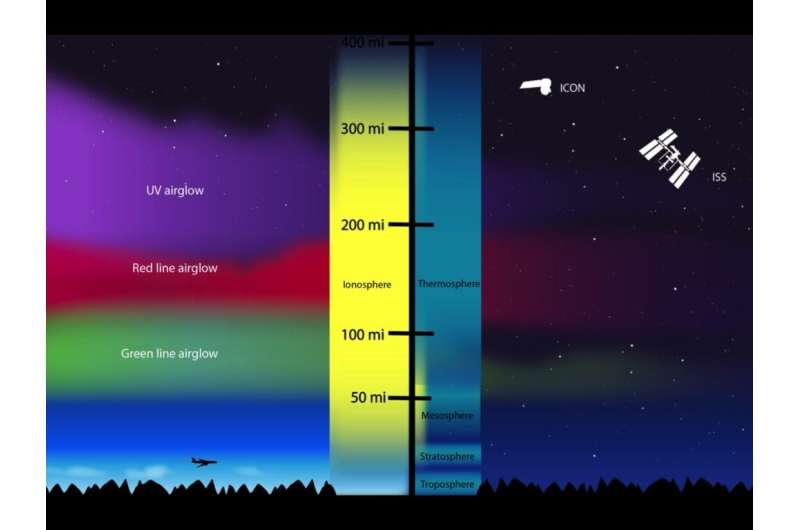The ionosphere and thermosphere (I-T) region sits roughly 50 to 400 miles above the Earth’s surface and will be studied by NASA’s Geospace Dynamics Constellation mission, which will launch in 2027 at the earliest. Credit: NASA
University of Michigan researchers will play a central role in NASA's upcoming Geospace Dynamics Constellation mission—a first-of-its-kind look at a protective outer layer of Earth's atmosphere and how it interacts with solar weather.
Solar weather poses a threat to Earth, with the potential to cause major damage to our power grids and satellites. NASA's Geospace Dynamics Constellation Mission, or GDC, includes three scientific investigations that will help us predict impacts from solar activity such as coronal mass ejections, solar wind and flares.
U-M is a leader in solar physics research, providing improved predictive tools for solar weather and its societal and technological impacts. The six satellites that make up GDC will provide the first direct global measurements of two overlapping layers of our atmosphere that are central to our defense against solar weather: the ionosphere and thermosphere. At an altitude range of roughly 50 to 400 miles above Earth's surface, they stand between the lower atmosphere and outer space, a buffer for the charged particles of the solar wind, flares and coronal mass ejections as well as X-ray and UV radiation.
Two of GDC's scientific instruments include U-M researchers:
- The Comprehensive Auroral Precipitation Experiment will measure high-energy particles entering the upper atmosphere. CAPE is led by U-M alum Daniel Gershman, currently with NASA's Goddard Space Flight Center. Aaron Ridley, a U-M professor of climate and space sciences and engineering is a contributor as well.
- Modular Spectrometer for Atmosphere and Ionosphere Characterization, or MoSAIC, will measure the ionosphere and thermosphere's composition, as well the winds that travel through it. Ridley is a contributing researcher.
"CAPE provides measurements of the northern and southern lights, or the aurora," Ridley said. "Both add energy to our upper atmosphere, causing it to swell like a balloon and altering trajectories of satellites and the International Space Station."
MoSAIC will quantify the atmospheric response to incoming auroral energy by measuring pressure and winds. That data will allow satellite operators to alter orbits to avoid collisions.
"I like to think of CAPE as the 'Doppler radar' of space weather," Gershman said. "Over the course of the GDC mission, CAPE will be able to produce local, regional and global space weather maps of electron and ion rain. These maps can be used to help predict big changes in the upper atmosphere, and therefore can help to keep satellites in low Earth orbit safe."
Ridley's involvement with multiple missions gives him a unique perspective on what GDC is attempting to accomplish.
"This is the first time that NASA will have launched this many satellites to do this sort of thing at once," Ridley said. "NASA has never dealt with this type of data before, in terms of having six satellites measuring the conditions in low-Earth orbit."
Before that can happen, there is much to be done. U-M researchers study how ions and neutrons interact, and how that creates instabilities in the atmosphere. Ridley is looking to build new models for the ionosphere and the thermosphere that capture disruption from the aurora, and more accurately predict space weather events.
NASA is currently considering five additional instruments—two of which may be selected—for inclusion in GDC. One instrument under consideration is headed by researchers with U-M ties.
Mark Moldwin, an Arthur F. Thurnau professor and a professor of climate and space sciences and engineering, heads the Near Earth Magnetometer Instrument in a Small Integrated System—one of the additional missions under consideration to be flown as part of the launch. The GDC supplements the aurora measurements with magnetic field measurements, capturing more of the energy entering the atmosphere. This function could be an opportunity to test a relatively new magnetometer technology that can be used on the smaller satellites that have become popular in recent decades.
Current satellites typically have their magnetometers attached via a long boom. The distance is necessary since spacecraft electronics emit their own magnetic field, making measurements trickier. Attaching long booms to smaller and smaller satellites is difficult.
"You want to get the magnetometers closer to the spacecraft," Moldwin said. "You'll see the magnetic signal from the craft, but with three magnetometers on a shortened boom, and some very clever math algorithms to sort noise from signal, we can clean up the data. This means that with more small magnetometers on a shorter (cheaper) boom, we can take out the magnetic fields from the electronics, allowing us to study the science."
Provided by University of Michigan
























